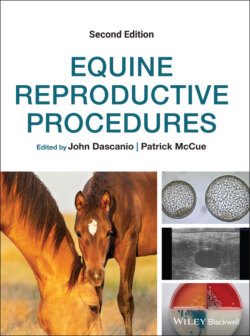Читать книгу Equine Reproductive Procedures - Группа авторов - Страница 98
Оглавление31 Prostaglandin E1 Treatment for Blocked Oviducts
Patrick M. McCue1 and Charles F. Scoggin2
1 Equine Reproduction Laboratory, Colorado State University, USA
2 Rood and Riddle Equine Hospital, USA
Introduction
Pathology of the equine oviducts is considered to be relatively uncommon. Confirmative diagnosis is tedious and expensive, and, in many instances, is made via exclusion of more common causes of infertility. Despite the rarity of oviductal disease, studies using dissected specimens have demonsrated a relatively high incidence of collagenous masses within the lumen of the oviducts. Furthermore, clinical reports have demonstrated that treatment for suspected cases of oviductal obstructions can improve pregnancy or embryo recovery rates in mares.
Methods to relieve oviductal obstructions or treat idiopathic infertility include flushing of the oviductal lumen or topical application of prostaglandin E2 (PGE2) to the serosal surface of the oviducts (see Chapters 30 and 32). A newer and separate technique involves deposition of misprostol (PGE1) onto the oviductal papillae or utero‐tubular junction (UTJ) by deep horn uterine infusion, using a similar technique as a deep horn insemination (see Chapter 48). The procedure can be performed either during diestrus or estrus, and involves passing a long flexible insemination pipette to the tip of a uterine horn, followed by infusion of PGE1 in the region of the oviductal papilla. Ultrasound guidance can be utilized to confirm pipette placement, and the procedure is subsequently repeated in the opposite horn. Immediately following deposition of PGE1, the horn can be held off or the base of the horn lifted dorsad to promote diffusion of PGE1 onto each papilla.
The use of this technique has not been compared with other methods of treating oviductal obstructions or unexplained infertility. A recent clinical study reported 68.2% success rate in obtaining pregnancies or recovering embryos within two cycles following PGE1 treatment in a small subset of infertile mares. This result appears similar to other methods, with a primary advantage being much lower costs relative to laparoscopy or hydrotubation. Additional studies are needed to confirm the efficacy of PGE1 therapy for blocked oviducts or idiopathic infertility.
Equipment and Supplies
Misoprostol tablets (200 μg/tab; Cytotec®, Pfizer, Inc., New York, USA), sterile water, 12 ml syringe, deep horn insemination pipette, sterile obstetrical sleeves, examination gloves, obstetrical lube. Optional: ultrasound with 5 MHz rectal probe.
Technique
The mare is restrained appropriately and her tail wrapped (see Chapter 4).
The rectum is evacuated and the perineum prepared routinely for a clean vaginal procedure (see Chapter 3).
A 200 μg tablet of misoprostol is dissolved in 3 ml of sterile water and the solution drawn up into a sterile, long, flexible insemination pipette attached to a sterile 12 ml syringe.
Using a sterile obstetrical sleeve and sterile lubricant, the insemination pipette is passed through the cervix and directed up a uterine horn.
The arm is withdrawn from the vagina and is then placed in the rectum to direct the pipette up the tip of the horn. Note: transrectal ultrasound can be used to confirm location of pipette tip.
Once the tip of the pipette is in the proper location, the misoprostol solution is infused. During and immediately following infusion, the tip of the horn can be held off or the base of the horn can be elevated dorsad to assist the solution in coming into contact with the uterine tube papillae.
Once complete, the tip of the pipette is withdrawn from the horn and redirected up to the tip of the other horn, and additional PGE1 is deposited as previously described.
Evaluation of the mare the following day is highly recommended. Some mares may experience an inflammatory response to this treatment, necessitating the use of ecbolics and/or uterine lavage.
Additional Comments
The procedure can be performed in estrus or diestrus.
Mares can be bred or inseminated as early as the day after PGE1 infusion.
Further Reading
1 Allen WR, Wilsher S, Morris L, et al. 2006. Re‐establishment of oviductal patency and fertility in infertile mares. Anim Reprod Sci 94: 242–3.
2 Allen WR, Wilsher S, Morris L, et al. 2006. Laparoscopic application of PGE2 to re‐establish oviductal patency and fertility in infertile mares: a preliminary study. Eq Vet J 38: 454–9.
3 Alvarenga MA, Segabinazzi LG. 2018. Application of misprostol as a treatment of unexplained infertility in mares. J Eq Vet Sci 71: 46–50.
4 Bradecamp EA, Schnobrich MR. 2016. Hysteroscopic hydrotubation of the oviducts as a treatment for idiopathic infertility in the mare – a retrospective study. Proc Annu Conv Soc Theriogenol 8(3): 337.
5 Inoue Y. 2013. Hysteroscopic hydrotubation of the equine oviduct. Eq Vet J 45: 761–5.
6 Inoue Y, Sekiguchi M. 2017. Clinical application of hysteroscopic hydrotubation for unexplained infertility in the mare. Eq Vet J 50: 470–3.
7 Ortis HA, Foss RR, McCue PM, Bradecamp EA, Ferris RA, Hendrickson DA. 2013. Laparoscopic application of PGE2 to the uterine tube surface enhances fertility in selected subfertile mares. J Eq Vet Sci 33(11): 896–900.
8 Tsunami Y, Suzuki H, Takeda T, et al. 1979. Evidence of the origin of the gelatinous masses in the oviducts of mares. J Reprod Fertil 57: 287–90.
